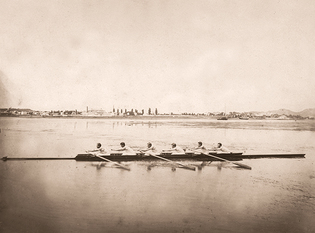
Henry S. Peck/Manuscripts and Archives
The Yale crew of 1865 rows in the race against Harvard in Worcester, Massachusetts. Weight lifting, running in heavy flannels, and beef and mutton were among the keys to their victory.
View full image
Like many traditions in these pandemic years, America’s oldest intercollegiate sporting event—the Yale-Harvard Regatta—was canceled in 2020 and 2021. The annual race between the Yale and Harvard rowing teams has been interrupted before, most often by war. In 1865, in the immediate aftermath of the Civil War, Yale won an important victory.
Rowing began at Yale in the 1840s as one of many new extracurricular pursuits, as the Yale student body—older on average than in earlier years—became bored with monotonous classroom drills. Students formed intramural rowing clubs to purchase boats, practice, and race in New Haven Harbor. On August 3, 1852, Yale and Harvard competed for the first time on Lake Winnipesaukee in New Hampshire, in a race organized by a local railroad to promote summer tourism. Yale lost by two lengths.
Harvard won the next three races, in 1855, 1859, and 1860, before the contest was suspended at the outbreak of the Civil War. In 1864, with many students away in the war and the boats manned by sophomores, Yale beat Harvard for the first time on Lake Quinsigamond in Worcester, Massachussetts, where the race was held from 1859 to 1870. But that win had a kind of asterisk attached to it, because so many athletes had been away at war. Yale still wanted to prove itself.
The crew came into the 1865 match in great shape after participating in Yale club races, exercising regularly with “rowing weights, dumbbells and Indian clubs,” and running “in heavy flannels for the purpose of melting off any possible fatty substance.” They ate “beef and mutton, with occasional chicken, toasted bread, boiled rice, and weak tea,” with “no wine or beer and very rarely vegetables.”
An observer noted that there was “enough at the annual race to make the sight at the Lake an enlivening one, whose counterpart can be found nowhere else in America. On the night preceding the race, there is a ‘citizens’ ball’ in one of the large public halls of the town, in which the students to some extent take part. . . . The college colors are liberally and often tastefully displayed in the costumes of the lady dancers.”
On July 28, the crowd of over 10,000 either sat in the bleachers for 50 cents or found a spot along the shore to track Yale and Harvard in their recently adopted blue and crimson colors. After a great start with Harvard briefly ahead, Yale led at the turn by two lengths. As rowing historian Thomas Mendenhall, Class of 1932, ’38PhD, described it: “Both turned well, and Harvard on the inside gained back a little. But [captain Wilbur Bacon ’66] put the beat up six or seven above Harvard to win going away in the fabulous time of 17:42 with Harvard 27 seconds behind.”
The New York Post wrote that Worcester had the atmosphere of “a fountain of youth. . . . By some process of soul-chemistry, the stains of the world have been expunged, years are rubbed out of the calendar, and there is nothing but youth and hope and joy.”
The memory of two glorious victories faded as Harvard won every year from 1866 to 1872. But in 1886 Yale took the ascendency, losing to Harvard only twice until 1906.
 loading
loading